NETGEAR WNR2000V3 User Manual
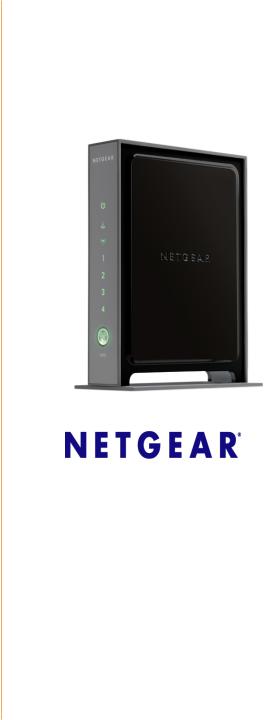
N300 Wireless Router
WNR2000v3 Setup
Manual
NETGEAR, Inc.
350 E. Plumeria Drive
San Jose, CA 95134 USA
August 2010 208-10658-01 v1.0
©2010 by NETGEAR, Inc. All rights reserved.
Trademarks
NETGEAR, NETGEAR genie, and the NETGEAR logo are trademarks of NETGEAR. Inc. Microsoft, Windows, and Windows NT are registered trademarks of Microsoft Corporation. Wi-Fi Protected Setup is a trademark of the Wi-Fi Alliance. Other brand and product names are registered trademarks or trademarks of their respective holders.
Statement of Conditions
In the interest of improving internal design, operational function, and/or reliability, NETGEAR reserves the right to make changes to the products described in this document without notice.
NETGEAR does not assume any liability that may occur due to the use or application of the product(s) or circuit layout(s) described herein.
ii
Contents
N300 Wireless Router WNR2000v3 Setup Manual |
|
Getting to Know Your Wireless Router................................................................................ |
1 |
Unpacking Your New Router ............................................................................................. |
1 |
Hardware Features ............................................................................................................ |
3 |
Front Panel .................................................................................................................. |
3 |
Back Panel .................................................................................................................. |
5 |
Router Label ................................................................................................................ |
6 |
Positioning Your Wireless Router ...................................................................................... |
6 |
Installing Your Wireless Router ......................................................................................... |
7 |
Updating Your Router Firmware ........................................................................................ |
8 |
Installing Your Router Using the NETGEAR genie ............................................................. |
9 |
Using the NETGEAR genie ............................................................................................... |
9 |
Accessing Your Router After Installation ......................................................................... |
11 |
Manually Installing Your Router ......................................................................................... |
12 |
Connecting Your Wireless Router ................................................................................... |
13 |
Verifying Your Connection ............................................................................................... |
16 |
Setting Up Your Router for Internet Access .................................................................... |
17 |
Configuring Your Wireless Network................................................................................... |
21 |
Setting Your SSID and Wireless Security ................................................................. |
22 |
Using Push 'N' Connect (WPS) to Configure Your Wireless Network ....................... |
23 |
Troubleshooting................................................................................................................... |
26 |
Basic Setup Checklist ...................................................................................................... |
26 |
Checking Basic Router Functions ................................................................................... |
27 |
Troubleshooting Login Problems ..................................................................................... |
29 |
Checking the Internet Service Connection ...................................................................... |
30 |
iii
Obtaining an Internet IP Address .................................................................................... |
30 |
Troubleshooting PPPoE ............................................................................................ |
31 |
Troubleshooting Internet Browsing ........................................................................... |
32 |
Using the Ping Utility to Troubleshoot ............................................................................. |
32 |
Testing the Path from Your Computer to Your Router .............................................. |
32 |
Testing the Path from a Computer to the Internet ..................................................... |
33 |
Technical Specifications ..................................................................................................... |
34 |
Default Configuration Settings ......................................................................................... |
34 |
Restoring the Default Password and Configuration Settings ........................................... |
36 |
Related Documents ............................................................................................................. |
37 |
Registration and Certifications........................................................................................... |
38 |
iv
Getting to Know Your Wireless Router
Congratulations on your purchase of a NETGEAR® high-speed wireless router, the N300 Wireless Router Model WNR2000v3.
Before you begin installing your router, check the package contents (see “Unpacking Your New Router” on page 1). Become familiar with the front and back panels of your router—especially the status lights—and the important information on the router label (see “Hardware Features” on page 3). Then, read the section on “Positioning Your Wireless Router” on page 6 to ensure that you have selected the best location to install your router.
Unpacking Your New Router
Your product package should contain the following items:
•The N300 Wireless Router
•A snap-on stand for your wireless router
•An AC power adapter (varies by region)
•A yellow Ethernet cable
•NETGEAR Installation Guide
•The Resource CD, which includes:
–The NETGEAR genie™ Installation Assistant (Autorun.exe)
–A PDF version of this manual
–A link to the online documentation.
If any of the parts are incorrect, missing, or damaged, contact your NETGEAR dealer. Keep the carton, including the original packing materials, in case you need to return the product for repair.
Getting to Know Your Wireless Router |
1 |
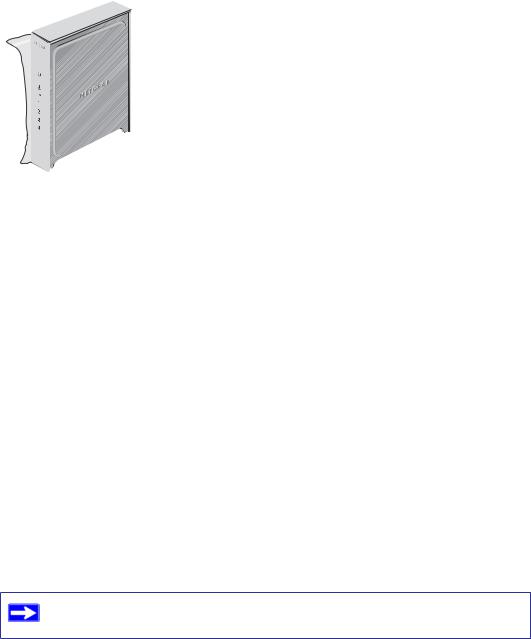
To prepare your router for installation:
1. Carefully peel off the protective film covering both sides of your router (see Figure 1).
Figure 1
2.Set up your wireless router by inserting the tabs of the stand (supplied with your router) into the slots on the bottom of your router as shown in Figure 2. Then, remove the protective film covering the status light panel of the router.
Figure 2
3.Place your router in a suitable area for installation (near an AC power outlet and accessible to the Ethernet cables for your wired computers).
To ensure proper heat dissipation and for router stability, it is important that you connect the stand and place your router in an upright position.
Getting to Know Your Wireless Router |
2 |
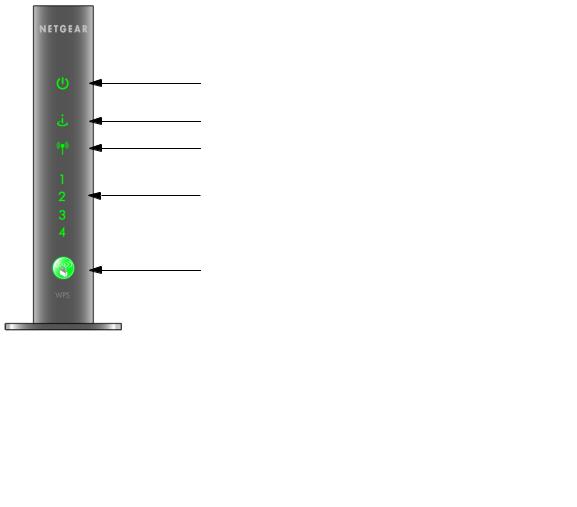
Hardware Features
Before you install and connect your router, take a moment to become familiar with the front and back panels of the router—especially the status lights on the front panel.
Front Panel
The router front panel, shown in Figure 3, contains status lights. (For more information on interpreting the status lights, see “Verifying Your Connection” on page 16 and “Checking Basic Router Functions” on page 27.)
1
2
3
4
5
Figure 3
You can use the status lights to verify various conditions.
Table 1. Status Light Descriptions
Label |
Activity |
Description |
|
|
|
|
Solid Amber |
The router is performing the power-on self-test diagnostic. |
1. Power |
Solid Green |
The power is on and the router is ready. |
|
Off |
Power is not being supplied to the router. |
|
|
|
Getting to Know Your Wireless Router |
3 |

Table 1. Status Light Descriptions (continued)
Label |
Activity |
Description |
||
|
|
|
|
|
|
|
Solid Amber |
No IP address acquired. |
|
2. |
Internet |
Solid Green |
The wireless router has acquired an Internet address. |
|
|
|
Off |
No Ethernet cable is connected to the modem. |
|
|
|
|
|
|
3. |
Wireless |
Solid Blue |
The wireless interface is enabled. |
|
Off |
The wireless interface is turned off. |
|||
|
|
|||
|
|
|
|
|
4. |
LAN |
Solid Green |
The local port is connected to a 100 Mbps device. |
|
Solid Amber |
The local port is connected to a 10 Mbps device. |
|||
|
(Ports 1–4) |
|||
|
|
Off |
No link is detected on this port. |
|
5. |
Push 'N' |
Solid Green |
Indicates that wireless security (WEP, WPA-PSK, or WPA2-PSK) is |
|
|
on. |
|||
|
Connect |
Off |
No WPS connection exists. |
|
|
|
|||
|
|
|
|
|
Getting to Know Your Wireless Router |
4 |
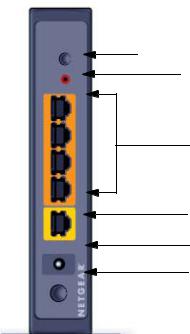
Back Panel
The router back panel, shown in Figure 4, contains port connections.
1
2
3
4
5
6
Figure 4
Viewed from top to bottom, the rear panel contains the following elements:
1.Wireless On/Off button.
2.Restore factory settings button. Press for approximately 5 seconds to reset the router to the factory default settings.
3.Four Local Area Network (LAN) 10/100 Mbps Ethernet ports for connecting the router to your local computers.
4.Internet/Wide Area Network (WAN) Ethernet port for connecting the router to a cable or DSL modem.
5.AC power adapter outlet for connecting the power adapter
6.Power on/off push-button.
Getting to Know Your Wireless Router |
5 |
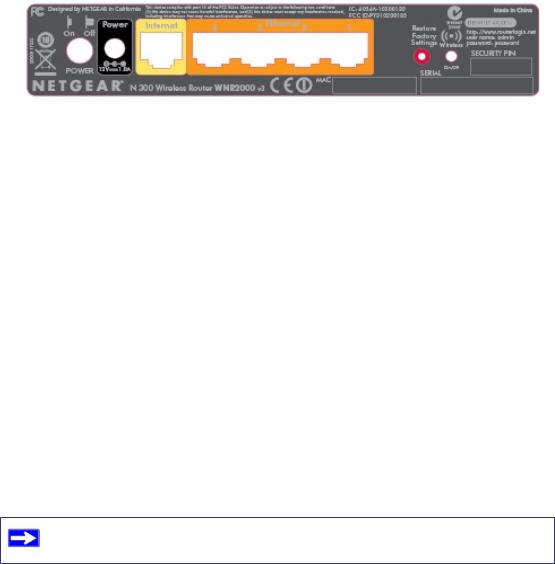
Router Label
The label on the back of the wireless router shows the router’s MAC address, serial number, security PIN, and factory default login information.
1.The ports on the router are color-coded to distinguish your Internet port from the other four ports that connect to the wired computer(s) on your Local Area Network (LAN).
Figure 5
Positioning Your Wireless Router
The wireless router lets you access your network from virtually anywhere within the operating range of your wireless network. However, the operating distance or range of your wireless connection can vary significantly depending on the physical placement of your router. For example, the thickness and number of walls the wireless signal must pass through might limit the range. For best results, place your router:
•Near the center of the area where your computers and other devices will operate, preferably within line of sight to your wireless devices.
•Accessible to an AC power outlet and near Ethernet cables for wired computers.
•In an elevated location such as a high shelf, keeping the number of walls and ceilings between the wireless router and your other devices to a minimum.
•Away from electrical devices which are potential sources of interference, such as ceiling fans, home security systems, microwaves, or the base for a cordless phone.
•Away from any large metal surfaces, such as a solid metal door or aluminum studs. Large expanses of other materials such as glass, insulated walls, fish tanks, mirrors, brick, and concrete can also affect your wireless signal.
Failure to follow these guidelines can result in significant performance degradation or an inability to wirelessly connect to the Internet.
Getting to Know Your Wireless Router |
6 |

Installing Your Wireless Router
To help you set up your router and get on the Internet quickly, the Resource CD contains a NETGEAR genie™ Installation Assistant. The Installation Assistant walks you through the steps required to connect your router, modem, and PC(s); configure your wireless settings; and enable wireless security for your network. When you have finished, you will be Internet ready!
NETGEAR does not recommend or support adding a NETGEAR router behind another router, or replacing a gateway with a NETGEAR router.
If you have a Linux system, you need to use the manual installation method (see “Manually Installing Your Router” on page 12).
You can set up your wireless router using one of two methods:
•NETGEAR genie Setup: The NETGEAR genie Installation Assistant setup is available on your Resource CD. See “Installing Your Router Using the NETGEAR genie” on page 9 to use the NETGEAR genie Installation Assistant.
–This is the easiest option. The wizard guides you through the setup process. It automates many of the steps and verifies that the steps have been successfully completed.
Before running the NETGEAR genie Installation Assistant on a corporate PC to set up your home router, check with your company’s network support staff. Corporate network settings or Virtual Private Network (VPN) client software might conflict with the default settings of a home router. If you are unsure about whether there might be a conflict, use a different computer.
•Manual Setup: If you cannot or prefer not to use the NETGEAR genie Installation Assistant, see “Manually Installing Your Router” on page 12. For example, if you are using a Linux operating system or are technically knowledgeable, select this option. If you choose to use this option and install your router manually, for best results, install and set up your router in this order:
1.Install and connect your wireless router to your network (see “Connecting Your Wireless Router” on page 13).
2.Set up your wireless router for Internet access (see “Setting Up Your Router for Internet Access” on page 17).
3.Configure your wireless network and select wireless security settings to protect your wireless network (see “Configuring Your Wireless Network” on page 21).
Getting to Know Your Wireless Router |
7 |
Updating Your Router Firmware
NETGEAR is always improving the operability and features included with your router. To make it easy for you to receive the best, most up-to-date features of your router, NETGEAR provides a variety of methods for updating your product.
•The NETGEAR genie Installation Assistant lets you check for and install updates as part of the setup activity (see “Using the NETGEAR genie” on page 9).
•The router includes an update feature that lets you check for and install updates. You must log in to the router to use this feature see “Setting Up Your Router for Internet Access” on
page 17, or the online User Manual).
Getting to Know Your Wireless Router |
8 |

Installing Your Router
Using the NETGEAR genie
The NETGEAR genie setup procedure should take about 15 minutes to complete. Before using the NETGEAR genie, ensure that:
•You are using a computer with either a Mac operating system or a Windows operating system (Windows 7, Windows Vista, Windows 2000, or Windows XP with Service Pack 2 or above).
•You have an Internet service connection through an Internet Service Provider (ISP).
•Your PC has a wired Ethernet connection (not a wireless connection).
•You have the configuration information provided by your ISP.
Using the NETGEAR genie
The NETGEAR NETGEAR genie takes you through the procedure to connect your router, modem, and PC(s). It then helps you to configure your wireless settings and enable wireless security for your network. The NETGEAR genie guides you through the setup process by automating many of the steps. At each step in the setup process, the NETGEAR genie checks to ensure that the steps you perform are successfully completed.
To set up your router using the NETGEAR genie:
1.To start the NETGEAR genie:
•For Windows users,
–Insert the Resource CD into your PC. The CD will automatically start and detect the language you are using on your PC. Select a different language option, if you prefer.
If the CD does not automatically start, browse the CD and double-click on  .
.
– In the CD’s menu, click Setup to start the NETGEAR genie.
•For Mac users, double-click the MacWizard program.
Installing Your Router Using the NETGEAR genie |
9 |
